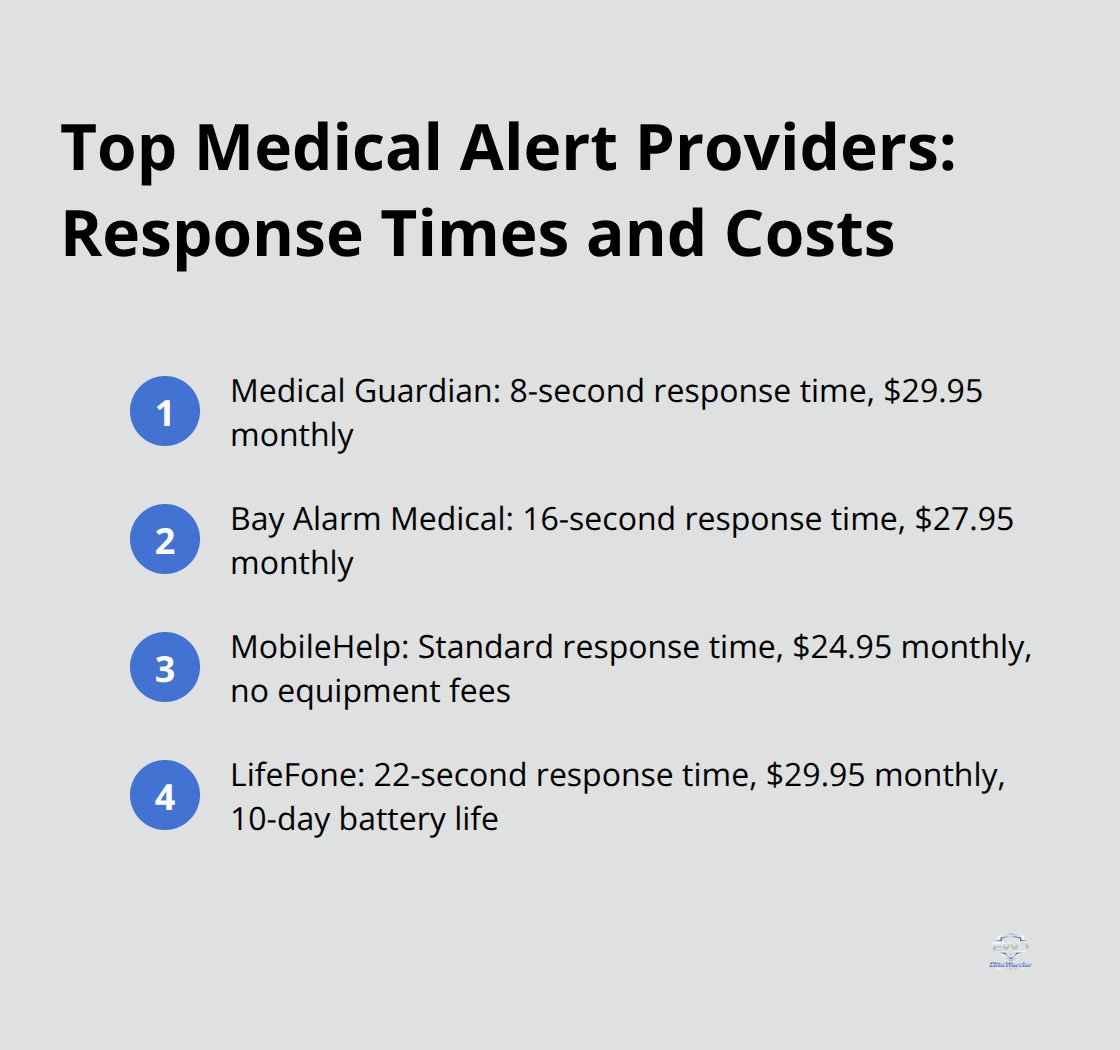Elite Warrior Defense
free shipping on orders over $25
We're having a 15% off sale on all our products. Enter your email below to be notified about future sales.

Medical alert systems for seniors have evolved dramatically, with 2025 bringing advanced GPS tracking, fall detection, and smartwatch integration that wasn’t available just five years ago.
We at Elite Warrior Defense LLC recognize that choosing the right system can feel overwhelming with dozens of providers offering different features and pricing structures. This guide breaks down everything you need to know to make an informed decision for yourself or a loved one.
The three main categories of medical alert systems in 2025 serve different lifestyles and mobility levels. In-home systems work best for seniors who spend most time at home and offer base stations with coverage ranges from 200 to 1,400 feet. Medical Guardian leads this category with the longest at-home range of 1,400 feet, while most competitors max out at 1,000 feet. These systems connect through landlines or cellular networks, with cellular options that provide more reliability since the median new home size reached 2,233 square feet in 2023.
Mobile and GPS-enabled systems have become the preferred choice for active seniors who leave home regularly. These devices use cellular networks and GPS technology to pinpoint exact locations during emergencies. MobileHelp offers the most budget-friendly mobile option that starts at $24.95 monthly with no equipment fees. The GPS feature proves invaluable for seniors with conditions like Alzheimer’s and allows centers to locate users anywhere within cellular coverage areas. Battery life varies significantly, with LifeFone that leads at 10 days compared to the standard 20-24 hours most competitors offer.
Smartwatch and wearable alert devices represent the fastest-growing segment and combine traditional emergency response with modern health monitoring. These devices integrate accelerometer technology for automatic fall detection, messaging capabilities, and companion apps for caregivers. The technology advancement allows users to maintain their normal routines without obvious medical devices. Most wearable systems include waterproof designs that address the reality that many falls occur in bathrooms where traditional pendants might be removed.
Response times separate good systems from great ones, with leading providers averaging under 30 seconds. Medical Guardian averages 8 seconds (the fastest recorded), while LifeFone averages 22 seconds and Bay Alarm Medical hits 16 seconds. These response times become critical during the golden hour after a fall, when 1 in 4 older adults report falling every year. The monitoring centers operate 24/7 with trained responders who assess situations and contact emergency services when needed.

Now that you understand the system types available, the next step involves identifying which specific features will make the biggest difference in your daily safety and peace of mind.
Professional monitoring services form the backbone of any effective medical alert system, and the quality varies dramatically between providers. Bay Alarm Medical delivers response times under 12 seconds with trained responders who answer calls every hour of every day, while some budget providers take over 60 seconds to respond. The monitoring center staff decides whether to contact family members, dispatch emergency services, or provide reassurance during false alarms. Medicare does not cover these monitoring fees (which range from $20 to $60 monthly), but the investment pays off when you consider that medical alert system users experience fewer emergency room visits.
Automatic fall detection represents the most significant advancement in medical alert technology, and it uses accelerometer sensors to detect sudden movements and impacts. More than one out of four older people falls each year, and falling once doubles your chances of falling again according to the Centers for Disease Control and Prevention. Fall detection typically adds $10 to $15 monthly to your base plan, but this feature activates even when users cannot press their emergency button. The technology works best when users wear devices consistently, which connects directly to the next critical consideration.
Battery performance and water resistance determine whether users actually wear their devices when emergencies occur. LifeFone leads the market with 10-day battery life compared to the standard 20-24 hours most competitors offer, which reduces the anxiety of frequent charges. Waterproof designs become essential since many falls happen in bathrooms where seniors might remove non-waterproof devices. Most quality systems now include IPX7 waterproof ratings that allow users to shower and swim while they wear the device.
Wall buttons offer backup emergency access for users who prefer to remove wearable devices at certain times. These buttons typically cost an additional $5 to $10 monthly but provide peace of mind throughout the home. Users can install multiple wall buttons in key locations like bedrooms, bathrooms, and kitchens to create comprehensive coverage zones.
The features you choose will directly impact your monthly costs, so understanding the pricing landscape helps you balance essential safety features with your budget constraints.
Life Alert dominated the medical alert market for decades but now charges premium prices without premium features. Their basic in-home system costs $69.95 monthly plus a $95 activation fee, which makes it one of the most expensive options available. Medical Guardian provides better value at $29.95 monthly with faster response times that average 8 seconds compared to Life Alert’s industry-standard 30 seconds. Bay Alarm Medical delivers the strongest combination of speed and affordability at $27.95 monthly with response times under 12 seconds and comprehensive customer service seven days per week.
MobileHelp leads the budget category at $24.95 monthly with no equipment fees, while LifeFone offers superior battery performance that lasts 10 days for $29.95 monthly. ADT leverages their security expertise to provide durable equipment and 14-second response times that start at $26.99 monthly. These newer companies skip the high activation fees that traditional providers charge, and most offer month-to-month contracts instead of long-term commitments. Fall detection adds $10 to $15 monthly across all providers, but the investment pays off since falls can significantly impact independence when help is delayed.

Medicare classifies medical alert systems as convenience items rather than durable medical equipment, so monthly fees come out of pocket. Some Medicare Advantage plans provide partial coverage, and Health Savings Accounts or Flexible Accounts can offset costs. AARP members receive discounts from several providers that include Bay Alarm Medical and Medical Guardian. Annual prepayment typically saves 10% to 15% compared to monthly payments, which brings effective costs down to $23 to $40 monthly for most systems.
Many providers charge activation fees between $25 and $100, equipment fees up to $200, and cancellation penalties that can reach $300. MobileHelp stands out by waiving equipment fees entirely, while Medical Guardian charges reasonable activation costs. Some companies require three-month minimum commitments, but the best providers offer true month-to-month flexibility without penalties.
Medical alert systems for seniors have transformed into essential safety tools that provide immediate emergency response when seconds count. Bay Alarm Medical leads with the best overall value at $27.95 monthly and delivers 16-second response times, while MobileHelp offers the most affordable option at $24.95 with no equipment fees. Medical Guardian provides the fastest response at 8 seconds for seniors who face higher fall risks.
Budget-conscious families should start with MobileHelp’s basic plan, while seniors with mobility concerns benefit from Medical Guardian’s advanced features. Active seniors need GPS-enabled mobile systems that track their location anywhere, and homebodies can save money with in-home options that cover up to 1,400 feet. Fall detection adds $10-15 monthly but proves worthwhile since one in four older adults experiences falls annually (making quick response times critical for maintaining independence).

Contact your top three providers for current rates and trial periods to test response times and device comfort firsthand. Most companies offer 30-day money-back guarantees that allow you to evaluate their service quality without risk. We at Elite Warrior Defense LLC understand that comprehensive safety extends beyond medical alerts to include personal protection and home security solutions that work together to create complete peace of mind for seniors and their families.